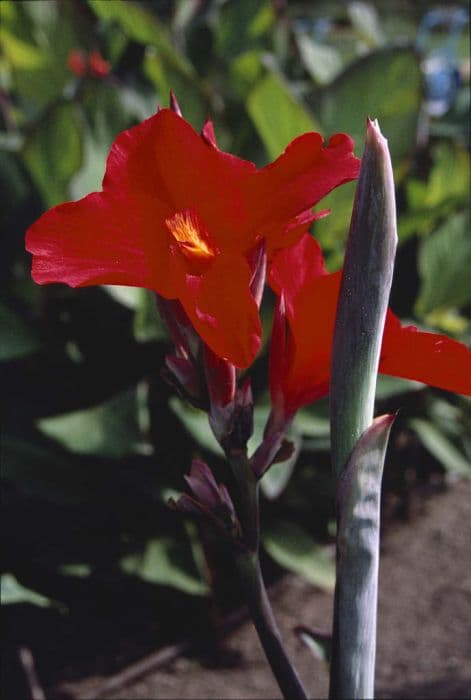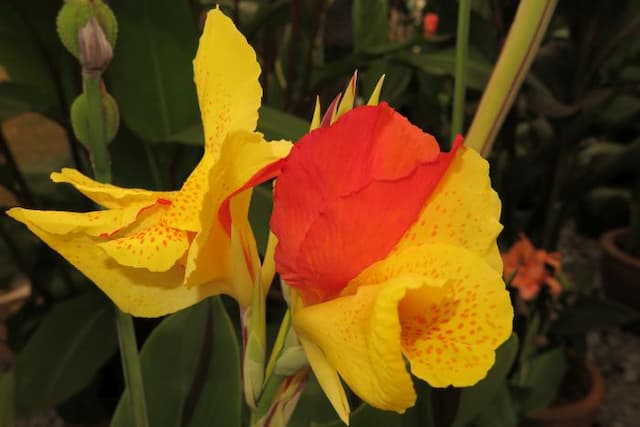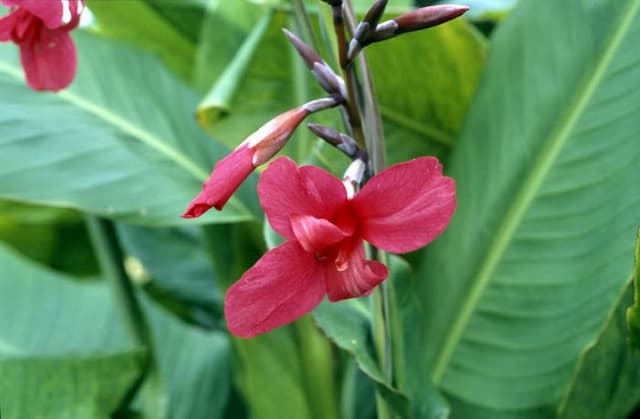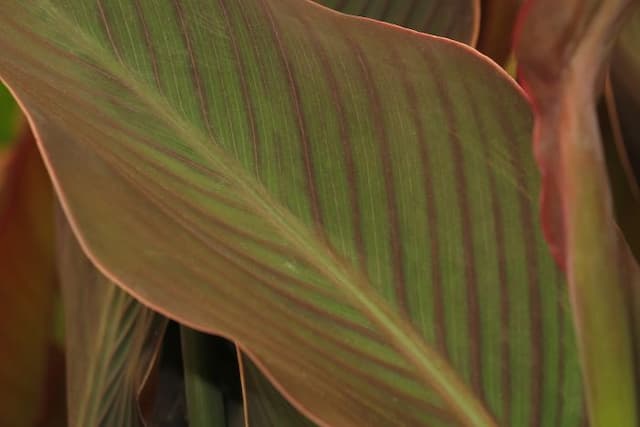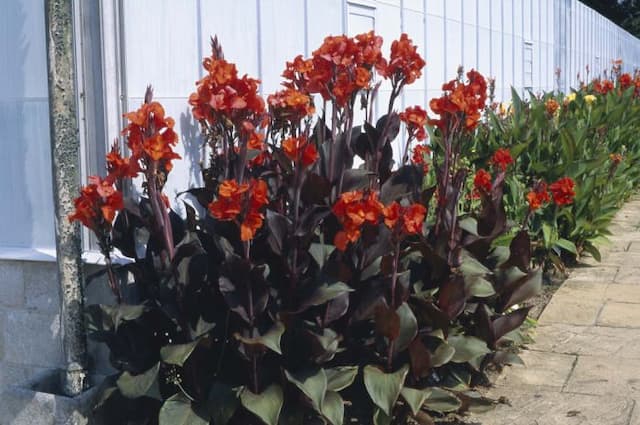Canna Lily Canna 'Shenandoah'

ABOUT
Canna 'Shenandoah' is a striking plant notable for its vibrant foliage and showy flowers. The leaves are a lush green, often with bronzy-maroon undertones, which can give the plant a fiery appearance, especially when backlit by sunlight. It is the flowers, however, that are the true highlight of this plant. The blooms come in a bold shade of red or orange, providing a dramatic contrast against the darker foliage. The flowers are large and showy, typically shaped like flared trumpets, which can make them a magnet for hummingbirds and other pollinators. The plant's overall appearance is tropical and lush, and it exudes an exotic charm that can add to the aesthetic of any garden space where color and vibrancy are desired.
About this plant
 Names
NamesFamily
Cannaceae.
Synonyms
Canna Lily, Indian Shot, Canna.
Common names
Canna 'Shenandoah'.
 Toxicity
ToxicityTo humans
The Canna or Canna Lily, including the 'Shenandoah' variety, is not considered toxic to humans. Therefore, ingestion of this plant typically does not lead to poisoning or serious side effects. However, as with any plant, individual allergies or sensitivities may occur, and it is generally not advisable to eat ornamental plants.
To pets
The Canna or Canna Lily, including the 'Shenandoah' variety, is generally not considered toxic to pets such as dogs and cats. Ingestion of this plant should not cause serious illness or poisoning in pets. As with humans, individual animals may have different levels of sensitivity, and it's always best to prevent pets from eating non-food plants to avoid any potential stomach upset or allergic reactions.
 Characteristics
CharacteristicsLife cycle
Perennials
Foliage type
Deciduous
Color of leaves
Green
Flower color
Orange
Height
4-5 feet (1.2-1.5 meters)
Spread
1-2 feet (0.3-0.6 meters)
Plant type
Bulb
Hardiness zones
7
Native area
Americas
Benefits
 General Benefits
General Benefits- Attractive Foliage: Canna 'Shenandoah' has striking leaves that add a lush, tropical look to gardens.
- Vibrant Blooms: It produces vibrant flowers that can add a pop of color to landscaping.
- Low Maintenance: This plant is relatively easy to care for, requiring minimal upkeep once established.
- Fast Growth: Can grow quickly, filling in spaces and providing immediate impact in garden designs.
- Drought Tolerance: Once established, it can tolerate periods of drought, making it suitable for drier climates.
- Pest Resistance: Can be resistant to many common pests, reducing the need for chemical treatments.
- Versatility in Landscaping: Can be used in a variety of garden settings, from borders to containers.
- Long Blooming Period: Has a long flowering season, providing color and interest for an extended period.
- Attracts Wildlife: Flowers can attract pollinators like hummingbirds and butterflies to your garden.
- Deer Resistant: Tends to be resistant to deer, which can be beneficial in areas where deer predation is a problem.
 Medical Properties
Medical PropertiesThis plant is not used for medical purposes.
 Air-purifying Qualities
Air-purifying QualitiesThis plant is not specifically known for air purifying qualities.
 Other Uses
Other Uses- Canna 'Shenandoah' can be used as a natural pest repellent in gardens due to its strong fragrance that is unappealing to some insects.
- The large leaves of Canna 'Shenandoah' can be used in crafting for creating impressions on clay or concrete for garden stepping stones.
- Canna 'Shenandoah' rhizomes, due to their high starch content, can be investigated as a potential source for bioethanol production.
- The fibers from Canna 'Shenandoah' can be used in the production of paper or as a sustainable textile alternative.
- Due to their vibrant colors, dried Canna 'Shenandoah' flowers can be used in potpourri mixes to add both color and a light fragrance to a room.
- Canna 'Shenandoah' plants are used in water filtration systems, particularly in constructed wetlands for wastewater treatment.
- The sturdy stems of Canna 'Shenandoah' can be harvested and used as natural stakes or supports for other plants in the garden.
- When dried, the seeds of Canna 'Shenandoah' can be used as beads for jewelry making or in percussion instruments as a natural rattle.
- Canna 'Shenandoah' is sometimes planted as a seasonal privacy screen due to its dense foliage and fast growth rate.
- The plant's vibrant blossoms and lush foliage make Canna 'Shenandoah' suitable for use as a natural dye in fabrics and art projects.
Interesting Facts
 Feng Shui
Feng ShuiThe Canna is not used in Feng Shui practice.
 Zodiac Sign Compitability
Zodiac Sign CompitabilityThe Canna is not used in astrology practice.
 Plant Symbolism
Plant Symbolism- Exotic Beauty: Cannas are often associated with exotic beauty due to their bold and vibrant flowers that stand out in any garden.
- Confidence: The plant's stature and the sturdiness of its stems symbolize confidence and the ability to stand tall in the face of adversity.
- Pride: With their flamboyant flowers, cannas can represent pride and self-assurance, reminding one to take pride in their individuality and achievements.
- Creativity: As cannas come in various colors and patterns, they are seen as symbolizing creativity and inspiration for artists and creative thinkers.
- Change and Transitions: The lifecycle of a canna plant, from rhizome to flower, can symbolize change and the beautiful transformations we undergo in life.
- Fertility and Prosperity: Due to their rapid growth and abundant blooms, cannas can represent fertility, abundance, and prosperity in one's life.
 Water
WaterCanna Lilies require consistent moisture, so water them thoroughly to soak the soil and then allow the top inch to dry out before watering again. During the growing season, water Canna Lilies about once a week with about 1 to 1.5 gallons per plant, but adjust the frequency depending on weather conditions – more often during hot, dry spells and less during cool, rainy periods. Avoid overhead watering to prevent disease and try to water early in the morning to allow for evaporation throughout the day.
 Light
LightCanna Lilies thrive in full sun, needing at least 6 to 8 hours of direct sunlight daily. Choose a spot in the garden that receives uninterrupted sunlight to ensure vibrant blooms and healthy growth. If you live in a particularly hot climate, providing light afternoon shade can help protect the plant from excessive heat.
 Temperature
TemperatureCanna Lilies perform best in warm temperatures, ideally between 60°F and 90°F. They can survive in temperatures as low as 55°F, but growth will be stunted. In regions where the temperature drops below 60°F for extended periods, it is recommended to dig up and store the rhizomes indoors over winter.
 Pruning
PruningPruning Canna Lilies involves removing dead or damaged foliage and spent flowers to encourage new growth and more blooms. Prune as needed throughout the growing season, and after the first frost, cut the plants down to a few inches above ground to prepare for winter. The best time for major pruning is in late winter or early spring before new growth begins.
 Cleaning
CleaningAs needed
 Soil
SoilThe best soil mix for Canna 'Shenandoah' should be rich, well-draining, and high in organic matter. A mix of garden soil, peat, and compost with good aeration will support robust growth. Maintain a soil pH of around 6.0 to 6.5 for optimal nutrient uptake.
 Repotting
RepottingCanna 'Shenandoah' typically needs repotting every 2 to 3 years or when it becomes pot-bound. It's best to repot in the spring, before the growing season begins.
 Humidity & Misting
Humidity & MistingCanna 'Shenandoah' thrives in moderate to high humidity levels but is tolerant of a range of conditions. Maintaining the humidity around 50-70% will promote healthy growth.
 Suitable locations
Suitable locationsIndoor
Provide bright light, keep soil moist, and ensure high humidity.
Outdoor
Full sun, rich soil, consistent watering, and protect from frost.
Hardiness zone
7-11 USDA
 Life cycle
Life cycleCanna 'Shenandoah', commonly known as Shenandoah Canna Lily, begins its life cycle as a rhizome that is planted after the danger of frost has passed. Upon planting, it sprouts to form lush green foliage and then starts to develop large, showy flowers that come in shades of red, orange, or yellow during the summer months. After flowering, the plant sets seed in the form of capsules, which can be collected for propagation or left to drop and potentially germinate nearby. As temperatures cool and daylight shortens in the fall, the Canna Lily enters a period of dormancy, withering above the ground while the rhizome overwinters. With the arrival of the next growing season, the rhizome generates new growth, and the cycle begins anew. The plant can also be propagated vegetatively by dividing the rhizomes during the dormant period.
 Propogation
PropogationPropogation time
Spring-summer
Propogation: The Canna 'Shenandoah', commonly known as Canna Lily, is typically propagated through division, which is the most popular and efficient method for this plant. The best time to propagate Canna Lilies by division is in the spring after the last frost when the plants are just beginning to grow, as this allows the divided rhizomes time to establish themselves during the growing season. To divide Canna Lilies, carefully dig up the clumps of rhizomes and wash or brush off the soil. Using a sharp knife, cut the rhizomes into sections, making sure each section has at least one eye or bud. These sections can then be replanted immediately in the garden at a depth of 3 to 4 inches (approximately 7.6 to 10 centimeters) and spaced about 1 to 2 feet (30 to 60 centimeters) apart, ensuring that the eyes are facing upwards. The divisions should be watered well after planting to help establish the new growth.

